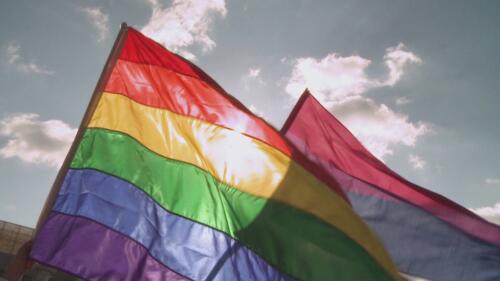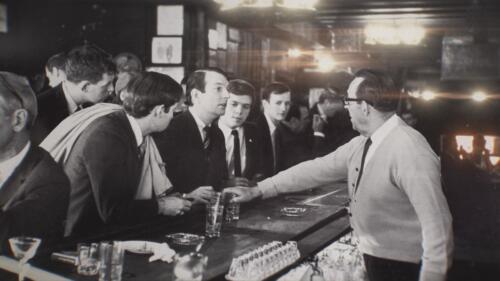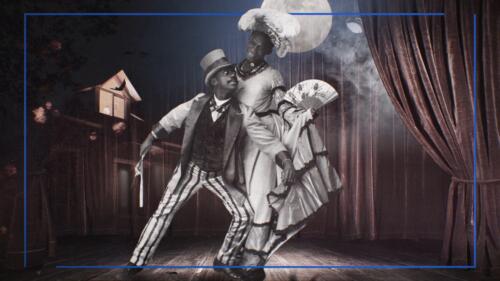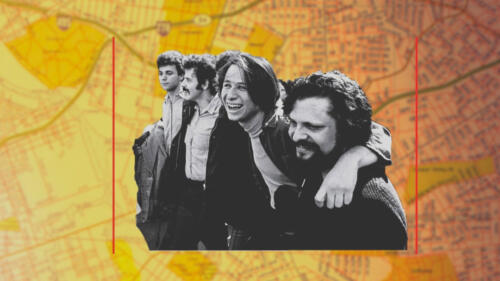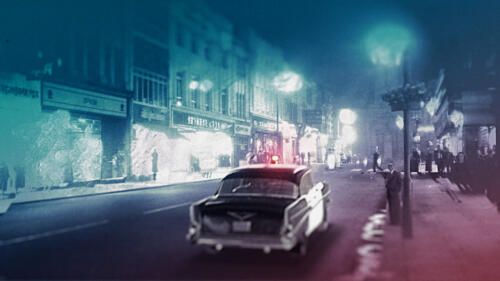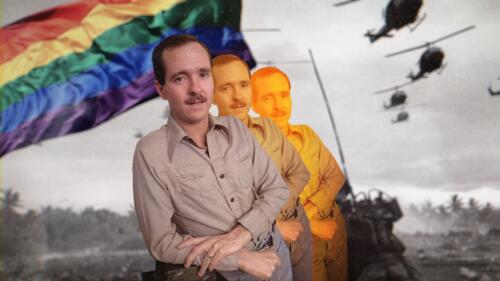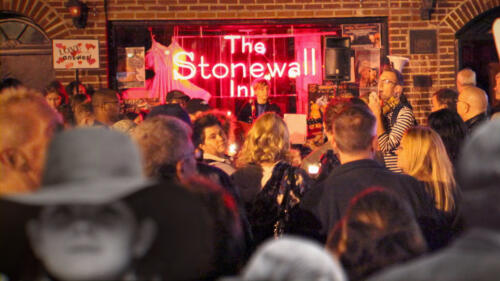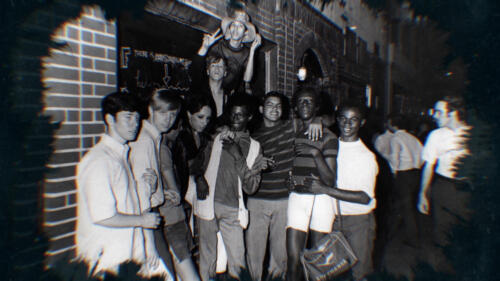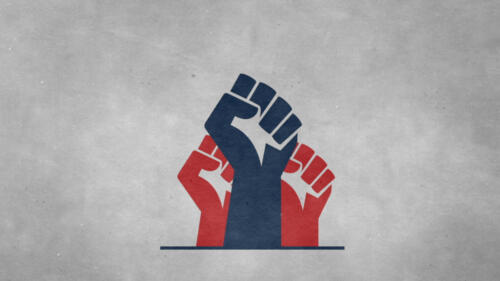LGBTQ+ History
LGBTQ+ history includes lesbian, gay, bisexual, transgender and queer people. Key moments in LGBTQ+ history include the Stonewall Riots, the assassination of Harvey Milk, the AIDS crisis and marriage equality.

Start Here

Before the Stonewall Riots, these activists helped set the stage for advances in the LGBTQ civil rights movement.

Harlem drag balls thrived during the post-Civil War era, creating a space where trans and queer people of color later broke out to develop House Ballroom.

The AIDS Memorial Quilt—with 1,920 individual panels, each inscribed with the names of people lost to AIDS—was displayed for the first time on October 11, 1987. It has grown ever since.

The Court ruled in favor of gay rights as early as 1958. But its decisions haven't always sided with the LGBT community.
Trans Rights
Cooper Do-nuts Protest Sparks the Trans Rights Movement
In 1959, Cooper Do-nuts set the stage for the trans rights movement.
3 Key Firsts in LGBTQ+ History
Explore All Related Topics

These establishments have long been places of refuge for queer people.

There is a long history of performers using clothing, makeup and hairstyles to express gender. These were among the first to make waves.

Czech track star Zdeněk Koubek had already set a world record in the women's 800-meter dash, when he announced in 1935 that he was going to be living as a man.

Alan Turing was a British mathematician and logician whose work laid the foundation for modern computer science and artificial intelligence. He was instrumental in breaking Nazi communication encryptions during World War II.

The Chevalier d’Éon (1728-1810) served as a French soldier, diplomat and spy—while living both as 'Charles' and 'Charlotte.'

Before the Stonewall Riots, these activists helped set the stage for advances in the LGBTQ civil rights movement.

The history of Pride Month began with the June 1969 Stonewall Riots and continues today with celebrations honoring the LGBTQ+ community.

During WWII and beyond, blue ticket discharges carried powerful stigma—and serious negative consequences.

The 1969 Stonewall Riots marked a historic turning point for gay rights, but several smaller uprisings preceded Stonewall as LGBTQ+ communities pushed back against harassment and inequality.

The organizers of the San Francisco event faced major challenges, including a lawsuit by the U.S. Olympic Committee.

Harlem drag balls thrived during the post-Civil War era, creating a space where trans and queer people of color later broke out to develop House Ballroom.

In an era when women were discouraged from entering the work force, these women forged ahead in a profession normally exclusive to men.

Some of the Golden Age of Hollywood's brightest stars were suspected to have been in "lavender" marriages—for the sake of their careers.

The struggle for LGBTQ rights dates at least as far back as 1924 and accelerated in the wake of the 1969 Stonewall Uprising.

In the 1940s, '50s and '60s, police arrested LGBTQ people based on an informal "three-article" rule. The Stonewall Riots helped turn the tide against these arrests.

The June 1969 riots at New York City's Stonewall Inn marked a raucous turning point in the fight for LGBTQ rights. Here's a timeline of how it unfolded.

The Court ruled in favor of gay rights as early as 1958. But its decisions haven't always sided with the LGBT community.

Fifty years later, Police Commissioner James P. O’Neill admits the police department enforced discriminatory laws.

Pink triangles were originally used in concentration camps to identify gay prisoners.

In 18th-century Britain, soldiers extorted money by threatening to accuse men of sodomy.

Batwoman's arrival in 1956 wasn't just about spicing up Batman and Robin’s routine.

In the late 19th century, psychiatrists and doctors began to label same-sex desire in medical terms—and looking for ways to reverse it.

According to a 2015 poll, DeGeneres did more to influence Americans’ attitudes about gay rights than any other celebrity or public figure.

In 1966, three men walked into a bar, stated they were gay and ordered drinks. When they were denied service, a movement began.

Baron Friedrich von Steuben was known for his bravery and the discipline and grit he brought to the American troops.

Denounced, questioned, pressured to resign and even fired, LGBT people were once rooted out of the State Department in what was known as the Lavender Scare.

Lord Alfred Douglas Wilde kept his homosexuality a secret. He married and had two sons. But in 1891, Wilde began an affair with Lord Alfred Douglas, a young British poet and aristocrat 16 years his junior. Douglas’ father, the Marquess of Queensberry, w...

Though Clinton admitted the policy was “not a perfect solution,” he presented it as a “major step forward” from the existing ban.

So-called 'Boston marriage' offered an alternative for women who didn’t want to depend on men.

Birth of the ACLU The National Civil Liberties Bureau (NCLB) formed in 1917 to provide legal aid for conscientious objectors of World War I and those being prosecuted for espionage and sedition. Conscientious objectors are individuals who refuse to perf...

The gay rights movement in the United States began in the 1920s and saw huge progress in the 2000s, with laws prohibiting homosexual activity struck down and a Supreme Court ruling legalizing same-sex marriage.

Edie Windsor and Jim Obergefell were fighting for basic spousal rights.

At 2:02 a.m. on June 12, 2016, a lone gunman entered Latin night at Pulse in Orlando and started to fire his bullets.

When the police raided the Stonewall Inn in 1969, the riots that ensued sparked a global movement.

The road to full marriage equality for same-sex couples in the United States was paved with setbacks and victories. The landmark 2015 Supreme Court case Obergefell v. Hodges made gay marriage legal throughout the country.

On May 21, 1979, thousands of members of San Francisco’s predominantly gay Castro District community took to the streets to protest the lenient sentence received by Dan White for the murders of local politician and gay rights activist Harvey Milk and Mayor George Moscone. Their anger–combined with the actions of police who arrived to quell […]

American politician and the first openly gay man to be elected to public office in California.

A Vietnam War veteran and drag performer came up with the iconic design in 1978.

The Stonewall Riots, also called the Stonewall Uprising, took place on June 28, 1969, in New York City, after police raided the Stonewall Inn, a local gay club. The raid sparked a riot among bar patrons and neighborhood residents as police hauled employees and patrons out of the bar, leading to six days of protests and violent clashes. The Stonewall Riots served as a catalyst for the gay rights movement.

Get the history behind the Comics Code Authority and how it kept some characters out of mainstream superhero stories for more than three decades.

Have you heard of these groundbreaking LGBT characters?
